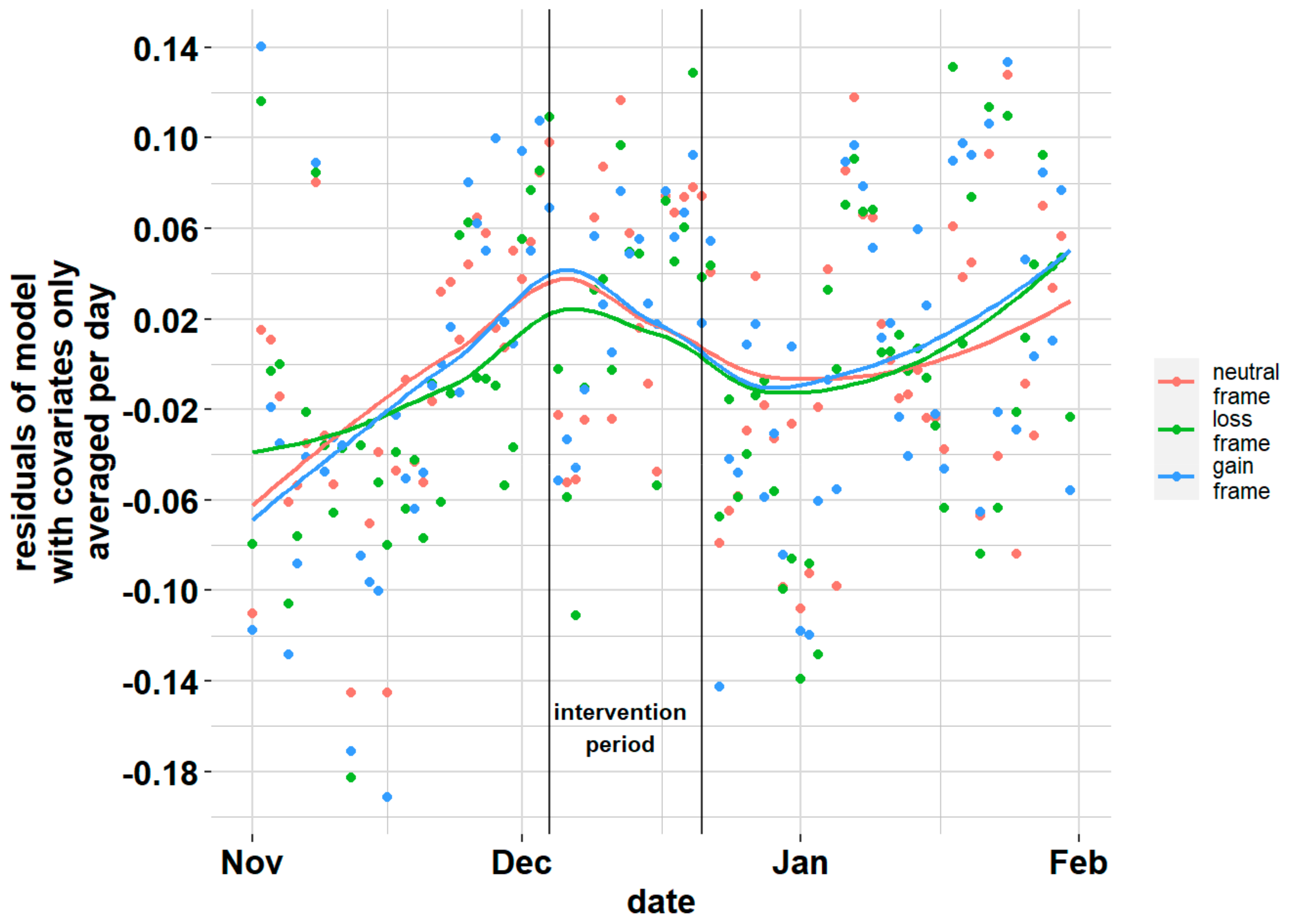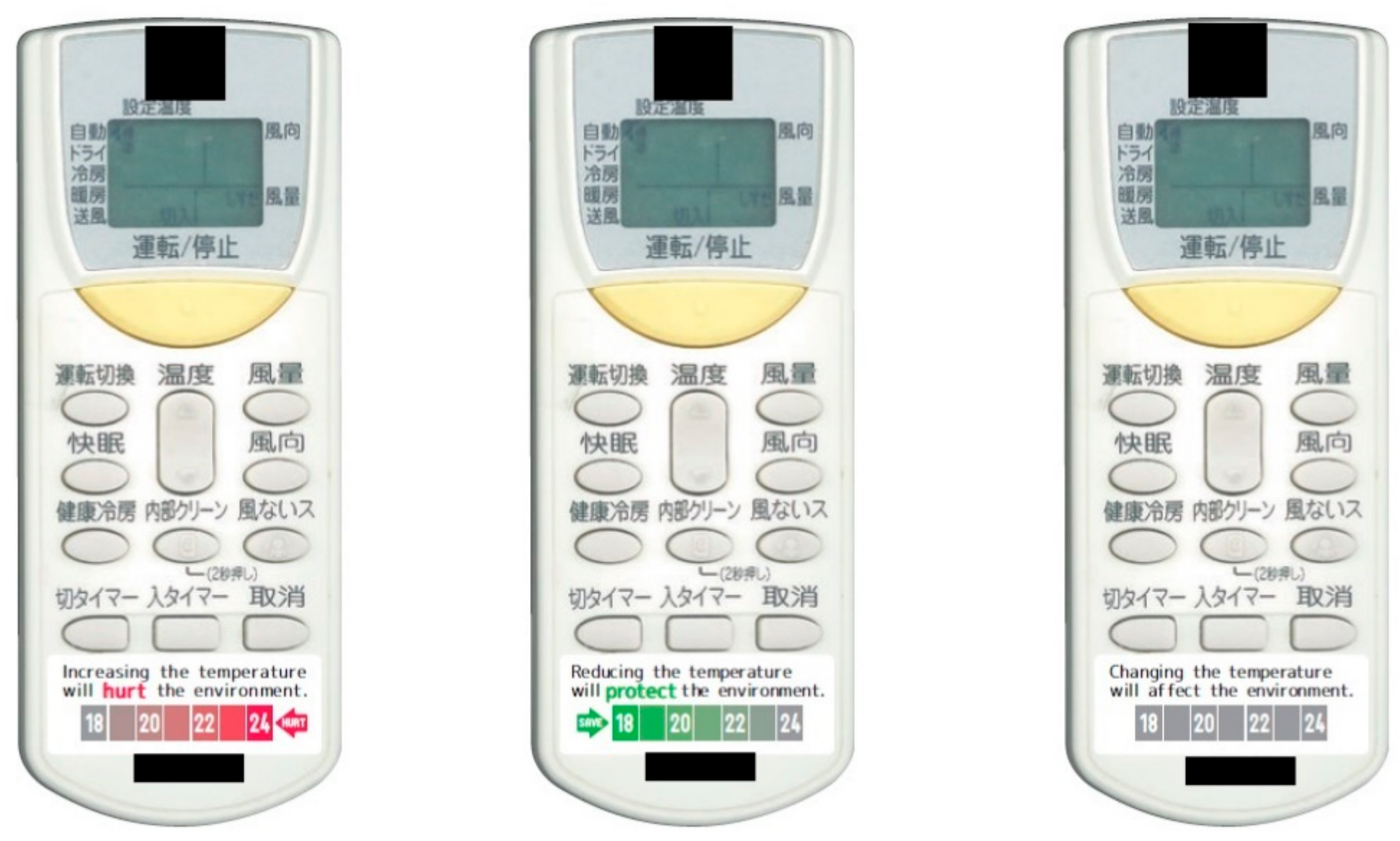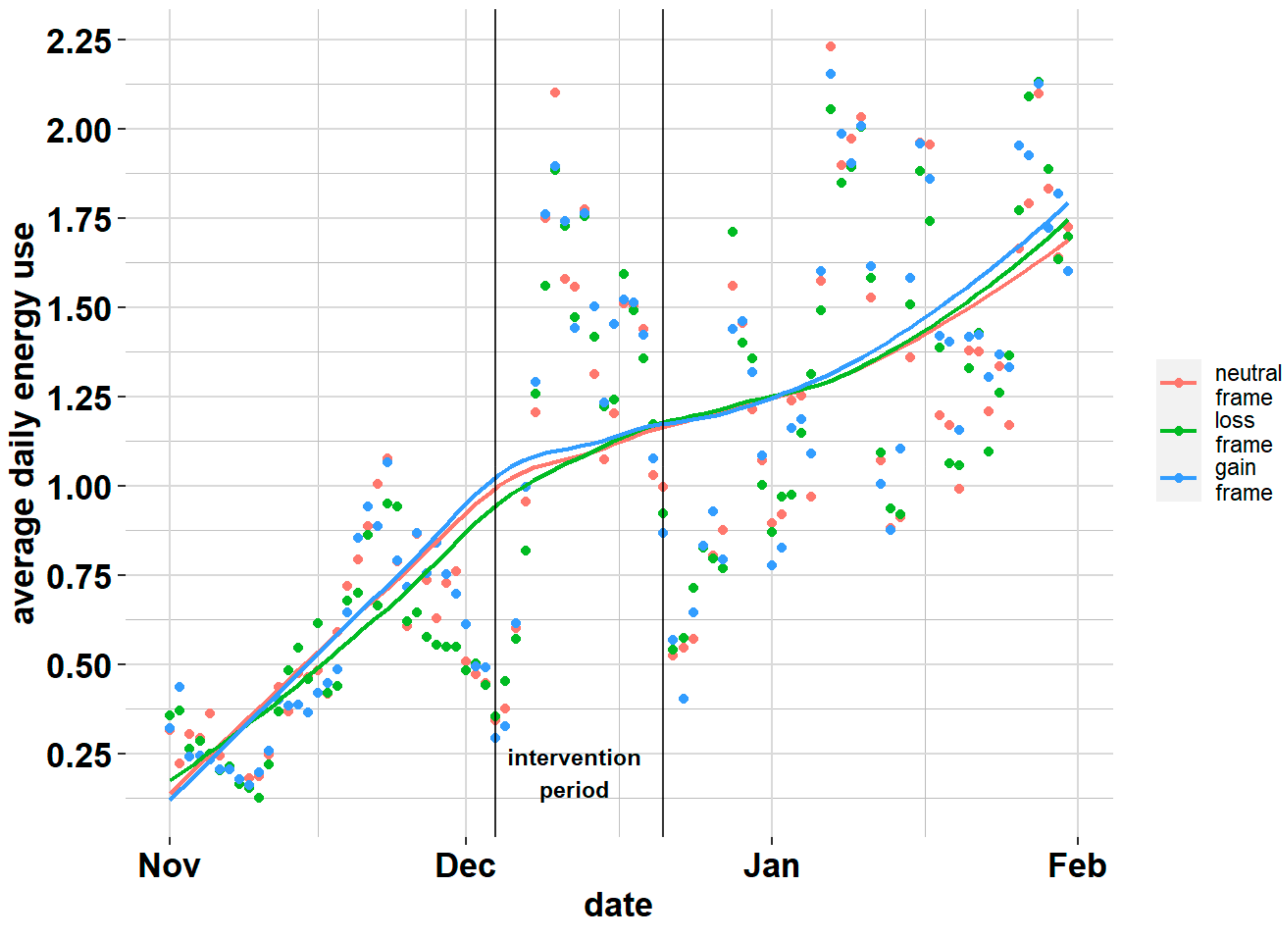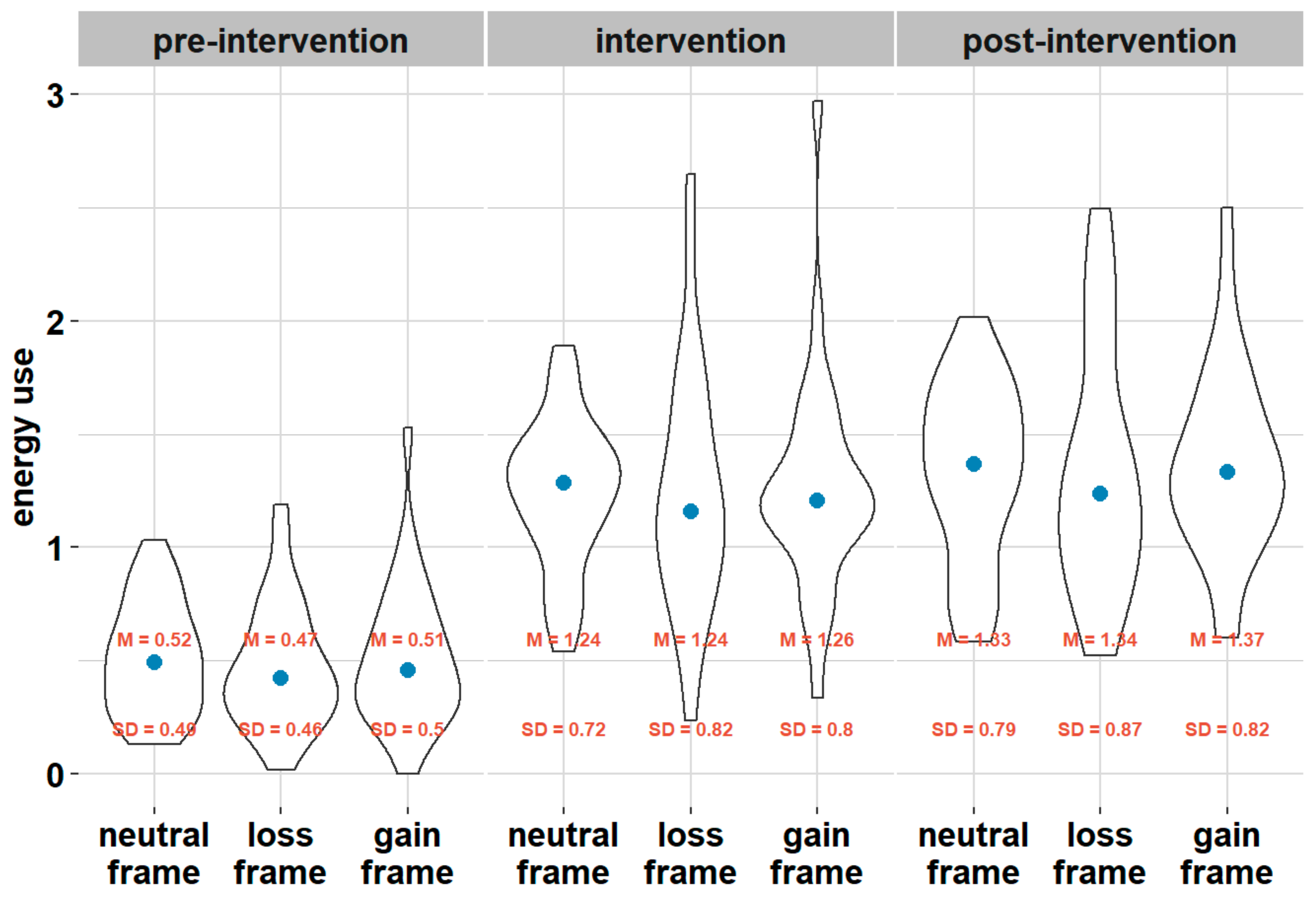Evaluating the Effect of Framing Energy Consumption in Terms of Losses versus Gains on Air-Conditioner Use: A Field Experiment in a Student Dormitory in Japan
Abstract
1. Introduction
2. Methodology
2.1. Study Site
2.2. Procedure
2.3. Data and Analysis
3. Results
4. Discussion
Author Contributions
Funding
Institutional Review Board Statement
Informed Consent Statement
Data Availability Statement
Acknowledgments
Conflicts of Interest
Appendix A
| Term | Estimate | Standard_Error | T | Df | P |
|---|---|---|---|---|---|
| (Intercept) | 0.4234 | 0.0429 | 9.879 | 68 | 0.0000 |
| temperature | −0.0441 | 0.0010 | −43.639 | 7627 | 0.0000 |
| airpressure | −0.0064 | 0.0007 | −8.804 | 7627 | 0.0000 |
| humidity | −0.0001 | 0.0003 | −0.244 | 7627 | 0.8069 |
| windspeed | −0.0133 | 0.0020 | −6.559 | 7627 | 0.0000 |
| weekdayThursday | −0.0073 | 0.0068 | −1.074 | 7627 | 0.2827 |
| weekdayFriday | −0.0169 | 0.0070 | −2.420 | 7627 | 0.0155 |
| weekdaySaturday | 0.0605 | 0.0083 | 7.293 | 7627 | 0.0000 |
| weekdaySunday | 0.0714 | 0.0083 | 8.564 | 7627 | 0.0000 |
| weekdayTuesday | 0.0028 | 0.0069 | 0.405 | 7627 | 0.6854 |
| weekdayWednesday | −0.0075 | 0.0070 | −1.074 | 7627 | 0.2826 |
| holidaylecture_day | −0.1539 | 0.0062 | −24.716 | 7627 | 0.0000 |
| periodintervention | 0.0778 | 0.0098 | 7.965 | 7627 | 0.0000 |
| periodpost_intervention | 0.0526 | 0.0094 | 5.596 | 7627 | 0.0000 |
| buildingB | −0.0781 | 0.0607 | −1.286 | 68 | 0.2027 |
| buildingC | 0.0725 | 0.0555 | 1.306 | 68 | 0.1961 |
| floor3 | −0.0101 | 0.0555 | −0.183 | 68 | 0.8557 |
| floor4 | 0.0409 | 0.0555 | 0.737 | 68 | 0.4636 |
| floor5 | 0.0316 | 0.0554 | 0.571 | 68 | 0.5699 |
| floor6 | 0.0540 | 0.0555 | 0.972 | 68 | 0.3343 |
| conditiongain_frame | 0.0087 | 0.0279 | 0.311 | 68 | 0.7564 |
| conditionloss_frame | −0.0154 | 0.0281 | −0.546 | 68 | 0.5870 |
| conditiongain_frame:periodintervention | 0.0025 | 0.0125 | 0.203 | 7627 | 0.8392 |
| conditiongain_frame:periodpost_intervention | 0.0110 | 0.0100 | 1.102 | 7627 | 0.2705 |
| conditionloss_frame:periodintervention | 0.0033 | 0.0125 | 0.264 | 7627 | 0.7915 |
| conditionloss_frame:periodpost_intervention | 0.0092 | 0.0100 | 0.919 | 7627 | 0.3581 |
| buildingB:floor3 | 0.1481 | 0.0858 | 1.726 | 68 | 0.0889 |
| buildingB:floor4 | 0.0289 | 0.0862 | 0.335 | 68 | 0.7388 |
| buildingB:floor5 | 0.0485 | 0.0858 | 0.566 | 68 | 0.5735 |
| buildingB:floor6 | 0.1858 | 0.0890 | 2.089 | 68 | 0.0405 |
| buildingC:floor3 | −0.0493 | 0.0784 | −0.629 | 68 | 0.5315 |
| buildingC:floor4 | −0.0035 | 0.0802 | −0.043 | 68 | 0.9658 |
| buildingC:floor5 | −0.0365 | 0.0822 | −0.444 | 68 | 0.6584 |

References
- IPCC. Summary for Policymakers. In Global Warming of 1.5 °C. An IPCC Special Report on the Impacts of Global Warming of 1.5 °C above Pre-Industrial Levels and Related Global Greenhouse Gas Emission Pathways, In the Context of Strengthening the Global Response to the Threat of Climate Change, Sustainable Development, and Efforts to Eradicate Poverty. 2018. Available online: https://www.ipcc.ch/site/assets/uploads/sites/2/2019/05/SR15_SPM_version_report_LR.pdf (accessed on 10 March 2021).
- Brewer, R.S.; Lee, G.E.; Johnson, P.M. The Kukui Cup: A Dorm Energy Competition Focused on Sustainable Behavior Change and Energy Literacy. In Proceedings of the 2011 44th Hawaii International Conference on System Sciences, Kauai, HI, USA, 4–7 January 2011; Available online: https://www.computer.org/csdl/pds/api/csdl/proceedings/download-article/12OmNzmLxLl/pdf (accessed on 10 March 2021).
- Petersen, J.E.; Frantz, C.M.; Shammin, M.R.; Yanisch, T.M.; Tincknell, E.; Myers, N. Electricity and water conservation on college and university campuses in response to national competitions among dormitories: Quantifying relationships between behavior, conservation strategies and psychological metrics. PLoS ONE 2015, 10, e0144070. [Google Scholar]
- Petersen, J.E.; Shunturov, V.; Janda, K.; Platt, G.; Weinberger, K. Does providing dormitory residents with feedback on energy and water use lead to reduced consumption. In Proceedings of the Greening the Campus VI, Muncie, IN, USA, 15–17 September 2005; Available online: </named-content>https://www.researchgate.net/publication/228634568_Dormitory_Residents_Reduce_Electricity_Consumption_When_Exposed_to_Real-Time_Visual_Feedback_and_Incentives (accessed on 10 March 2021).
- Petersen, J.E.; Shunturov, V.; Janda, K.; Platt, G.; Weinberger, K. Dormitory residents reduce electricity consumption when exposed to real-time visual feedback and incentives. Int. J. Sustain. High. Educ. 2007, 8, 16–33. [Google Scholar] [CrossRef]
- Romanowicz, J.; Jennings, N.; Kaklauskas, A.; Laskari, M.; Tsekeri, E.; Charalambous, C.; Lambrou, C.; Sjolin, E.; Bull, R.; Everitt, D.; et al. Students Achieving Valuable Energy Savings: Project Report 2014-17. 2017. Available online: https://s3-eu-west-1.amazonaws.com/nusdigital/document/documents/34529/2a0cb6a7d13f6081a4125321e1af88a6/20170328_publishable_report_-_final_draft.pdf (accessed on 10 March 2021).
- Bekker, M.J.; Cumming, T.D.; Osborne, N.K.; Bruining, A.M.; McClean, J.I.; Leland, L.S., Jr. Encouraging electricity savings in a university residential hall through a combination of feedback, visual prompts, and incentives. J. Appl. Behav. Anal. 2010, 43, 327–331. [Google Scholar] [CrossRef] [PubMed]
- Jain, M.; Chhabra, D.; Singh, A. Comparing Energy Feedback Techniques for Dormitory Students in India. BuildSys’15. In Proceedings of the 2nd ACM International Conference on Embedded Systems for Energy-Efficient Built, Seoul, South Korea, 4–5 November 2015; Available online: http://www.dgp.toronto.edu/~mjain/BuildSys-2015.pdf (accessed on 10 March 2021).
- Odom, W.; Pierce, J.; Roedl, D. Social incentive & eco-visualization displays: Toward persuading greater change in dormitory communities. In Proceedings of the Public and Situated Displays to Support Communities Workshop, OZCHI, Cairns, QLD, Australia, 9 December 2008; Available online: https://www.researchgate.net/publication/228492450_Social_Incentive_Eco-Visualization_Displays_Toward_Persuading_Greater_Change_in_Dormitory_Communities (accessed on 10 March 2021).
- Abrahamse, W.; Steg, L.; Vlek, C.; Rothengatter, T. A review of intervention studies aimed at household energy conservation. J. Environ. Psychol. 2005, 25, 273–291. [Google Scholar] [CrossRef]
- Kaiser, F.G.; Henn, L.; Marschke, B. Financial rewards for long-term environmental protection. J. Environ. Psychol. 2020, 68, 101411. [Google Scholar] [CrossRef]
- Lehman, P.K.; Geller, E.S. Behavior analysis and environmental protection: Accomplishments and potential for more. Behav. Soc. Issues 2004, 13, 13–33. [Google Scholar] [CrossRef]
- Maki, A.; Burns, R.J.; Ha, L.; Rothman, A.J. Paying people to protect the environment: A meta-analysis of financial incentive interventions to promote proenvironmental behaviors. J. Environ. Psychol. 2016, 47, 242–255. [Google Scholar] [CrossRef]
- Bolderdijk, J.W.; Steg, L.; Geller, E.S.; Lehman, P.K.; Postmes, T. Comparing the effectiveness of monetary versus moral motives in environmental campaigning. Nat. Clim. Chang. 2013, 3, 413–416. [Google Scholar] [CrossRef]
- Dogan, E.; Bolderdijk, J.W.; Steg, L. Making small numbers count: Environmental and financial feedback in promoting eco-driving behaviours. J. Consum. Policy 2014, 37, 413–422. [Google Scholar] [CrossRef]
- Spence, A.; Leygue, C.; Bedwell, B.; O’malley, C. Engaging with energy reduction: Does a climate change frame have the potential for achieving broader sustainable behaviour? J. Environ. Psychol. 2014, 38, 17–28. [Google Scholar] [CrossRef]
- Steinhorst, J.; Klöckner, C.A. Effects of monetary versus environmental information framing: Implications for long-term pro-environmental behavior and intrinsic motivation. Environ. Behav. 2018, 50, 997–1031. [Google Scholar] [CrossRef]
- Herziger, A.; Berkessel, J.B.; Steinnes, K.K. Wean off green: On the (in) effectiveness of biospheric appeals for consumption curtailment. J. Environ. Psychol. 2020, 69, 101415. [Google Scholar] [CrossRef]
- Kesenheimer, J.S.; Greitemeyer, T. Ego or Eco? Neither Ecological nor Egoistic Appeals of Persuasive Climate Change Messages Impacted Pro-Environmental Behavior. Sustainability 2020, 12, 10064. [Google Scholar] [CrossRef]
- Sloot, D.; Jans, L.; Steg, L. Is an Appeal Enough? The Limited Impact of Financial, Environmental, and Communal Appeals in Promoting Involvement in Community Environmental Initiatives. Sustainability 2021, 13, 1085. [Google Scholar] [CrossRef]
- White, K.; Habib, R.; Hardisty, D.J. How to SHIFT consumer behaviors to be more sustainable: A literature review and guiding framework. J. Mark. 2019, 83, 22–49. [Google Scholar] [CrossRef]
- Cheng, T.; Woon, D.K.; Lynes, J.K. The use of message framing in the promotion of environmentally sustainable behaviors. Soc. Mark. Q. 2011, 17, 48–62. [Google Scholar] [CrossRef]
- Frederiks, E.R.; Stenner, K.; Hobman, E.V. Household energy use: Applying behavioural economics to understand consumer decision-making and behaviour. Renew. Sustain. Energy Rev. 2015, 41, 1385–1394. [Google Scholar] [CrossRef]
- Homar, A.R.; Cvelbar, L.K. The effects of framing on environmental decisions: A systematic literature review. Ecol. Econ. 2021, 183, 106950. [Google Scholar] [CrossRef]
- Lange, F.; Dewitte, S. Measuring pro-environmental behavior: Review and recommendations. J. Environ. Psychol. 2019, 63, 92–100. [Google Scholar] [CrossRef]
- Gonzales, M.H.; Aronson, E.; Costanzo, M.A. Using Social Cognition and Persuasion to Promote Energy Conservation: A Quasi-Experiment 1. J. Appl. Soc. Psychol. 1988, 18, 1049–1066. [Google Scholar] [CrossRef]
- Shinohara, H. Ryousei No Denryoku Shouhiryou No Zittai Oyobi Shouene Potential No Kanousei Nikansuru Kenkyu: Kokusaigakuyuuryou Nadeshiko No Eakon Shiyou Wo Zireini. Bachelor’s Thesis, Fukuoka Women’s University, Fukuoka, Japan, 2018. [Google Scholar]
- Japan Meteorological Agency. Kako No Kishou Data Kensaku. 2021. Available online: http://www.data.jma.go.jp/obd/stats/etrn/index.php (accessed on 10 March 2021).
- Lange, F.; Steinke, A.; Dewitte, S. The Pro-Environmental Behavior Task: A laboratory measure of actual pro-environmental behavior. J. Environ. Psychol. 2018, 56, 46–54. [Google Scholar] [CrossRef]
- Moshontz, H.; Campbell, L.; Ebersole, C.R.; IJzerman, H.; Urry, H.L.; Forscher, P.S.; Gragem, H.E.; McCarthy, R.J.; Musser, E.D.; Antfolk, J.; et al. The Psychological Science Accelerator: Advancing psychology through a distributed collaborative network. Adv. Methods Pract. Psychol. Sci. 2018, 1, 501–515. [Google Scholar] [CrossRef] [PubMed]




Publisher’s Note: MDPI stays neutral with regard to jurisdictional claims in published maps and institutional affiliations. |
© 2021 by the authors. Licensee MDPI, Basel, Switzerland. This article is an open access article distributed under the terms and conditions of the Creative Commons Attribution (CC BY) license (https://creativecommons.org/licenses/by/4.0/).
Share and Cite
Iwasaki, S.; Franssens, S.; Dewitte, S.; Lange, F. Evaluating the Effect of Framing Energy Consumption in Terms of Losses versus Gains on Air-Conditioner Use: A Field Experiment in a Student Dormitory in Japan. Sustainability 2021, 13, 4380. https://doi.org/10.3390/su13084380
Iwasaki S, Franssens S, Dewitte S, Lange F. Evaluating the Effect of Framing Energy Consumption in Terms of Losses versus Gains on Air-Conditioner Use: A Field Experiment in a Student Dormitory in Japan. Sustainability. 2021; 13(8):4380. https://doi.org/10.3390/su13084380
Chicago/Turabian StyleIwasaki, Shimpei, Samuel Franssens, Siegfried Dewitte, and Florian Lange. 2021. "Evaluating the Effect of Framing Energy Consumption in Terms of Losses versus Gains on Air-Conditioner Use: A Field Experiment in a Student Dormitory in Japan" Sustainability 13, no. 8: 4380. https://doi.org/10.3390/su13084380
APA StyleIwasaki, S., Franssens, S., Dewitte, S., & Lange, F. (2021). Evaluating the Effect of Framing Energy Consumption in Terms of Losses versus Gains on Air-Conditioner Use: A Field Experiment in a Student Dormitory in Japan. Sustainability, 13(8), 4380. https://doi.org/10.3390/su13084380






